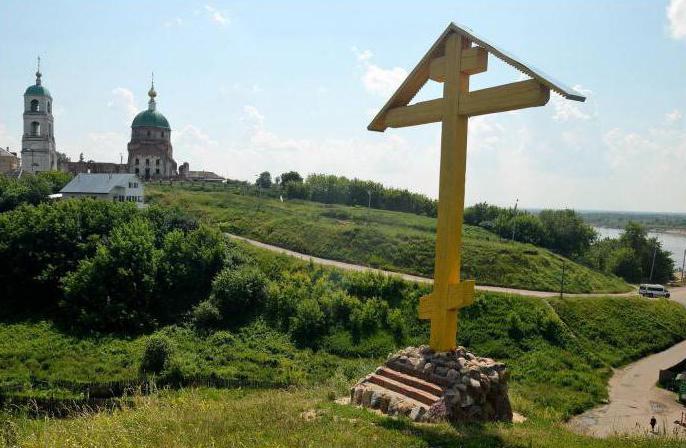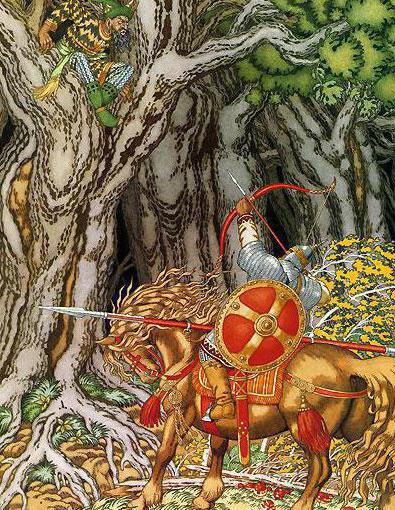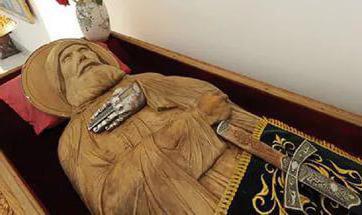Ilya Muromets is a rather famous, but very, very mysterious hero, about which many interesting legends and epics have been and still are. It is almost impossible to find a person who would not have heard about the heroic deeds of the hero. Most often, people's knowledge about Ilya Muromets is gleaned from a small number of Russian folk tales, but the truth, oddly enough, remains in the shadows.
The complex and multifaceted image of the hero of even some scientists and philosophers is misleading. The relics of Ilya Muromets have been thoroughly studied for a long time. What this led to will be described below.
True or fiction?
Already about 200 years has been spent by scientists to at least get closer to unraveling the secrets of the hero of the hero, nevertheless, most attempts remain in vain. People living in the distant 16-19th centuries did not even have a shadow of doubt in the fact that Ilya Muromets existed and actually performed feats. It is also known that the Russian hero was a soldier and served in the regiment of the prince of the glorious city of Kiev. Ancient Russian legends do not in any way doubt the origin of the hero, whose hometown is considered to be Moore. Nevertheless, historical information suggests that his true homeland is the village of Karacharovo, located in the Murom region. Perhaps these data do not contradict each other. After all, it is not without reason that the city of Murom keeps the relics of Ilya Muromets. The address of the monastery where they rest is ul. Lakin, 1.
Homeland of the hero
However, modern figures of historical sciences believe that in fact Muromets was born and lived for a long time in the Chernihiv region. Not far from this place there are such settlements as Karachev and Moroviysk, where they remember about the heroic deeds and life of a hero and never tire of arguing to this day. If you look at this information with a knowledge of geography, you can understand that the information is absurd, since these cities are many hundreds of kilometers apart.
Why is the hero - Muromets?
Nevertheless, it is worth taking into account the fact that these three cities, that is, Murom, Chernihiv and Karachev, are approximately in the same direction from Kiev.

Accordingly, this territory could well become the site of the most famous military achievements of the ancient Russian hero of epics. Nearby is the village of Nine Oaks, passing by which, the Russian hero Ilya Muromets got to the place of service. Accordingly, there are no significant differences between official history and folk epics and legends. Also a very remarkable fact is that Murom was a part of the Chernigov Principality for a very long time. Comparison of the name of the city and the name of the epic hero is quite justified, since the cities of Murom and Chernihiv for a very long time were an important part of both Vladimir-Suzdal and Moscow and Kievan Rus. These places are still considered the historical homeland of the hero. It is not for nothing that a particle of the relics of Ilya of Muromets is kept in Murom today.
The first mention of Muromets
Oddly enough, the old Russian chronicles do not have information about Ilya Muromets, while even in distant Germany this historical hero is rightfully recognized as one of the main persons of the poetic works of the 18th century, which are based on earlier epic creations. In these writings, Ilya Muromets appears before the readers in the image of the mighty warrior and hero of Ilya of Russia. As for official documents, the name of Muromets first appears in them in the distant 1574.
Feats of the Knight Ilya of Muromets
Since Ilya was a staunch Christian by religion, brought up according to all the laws and canons of faith in Jesus, before going to the feats, he bows to his parents and the whole family to the earth. Bowing, Ilya asked his father and mother for blessings and parting words. Legends explain that Ilya’s mother and father, despite their own weakness and weakness, agreed to the exploits of his son and let him go on a long journey, only giving memory a handful of the native land of the city of Murom. Parents also took an oath from their son that people holding Christianity would not die from his sword. Ilya Muromets confirmed fidelity to the word given to his parents by the fact that all Christians remained alive, and justice reigned in Russia and truth triumphed.
Significant battles
As soon as Muromets heard approval from his parents, his path lay in the Principality of Vladimir, from where the process of his ministry began. The hero was the only one who decided to go to the prince in the most difficult times for Russia. Having met the robbers, Ilya chose to avoid war and fired an arrow from a bow into a centuries-old oak tree, which grew very close. The arrow, which fell right in the middle of the tree, broke the oak into the smallest slivers, which shocked the robbers, and they, bowing in unison and showing respect, missed the knight forward, not starting the battle.

Historical evidence suggests that the next battle in which Ilya won is the battle with the Nightingale the Robber, a mythical creature that symbolizes the pagan principle. That is why the hero, a true believer in the existence of Christ, tried to lead a fierce duel with the robber. To prove that the hero was a supporter of the Christian faith, many historians and great figures of fine art are trying to capture the hero with a cross-shaped spear in arms.
Prince's reception
Remembering the instructions of his mother, Muromets before each battle attempted to convince the enemies to end everything peacefully. Thus, it can be argued that the famous hero has almost unlimited endurance, patience and mercy.
Most of the stories about the military service of Ilya Muromets originate from the moment of a noble feast in the palace of Prince Vladimir. The hero got to this feast as soon as he ended up in Kiev. The guests had the opportunity to sit down at any places at the table, and Ilya, before sitting down and starting festivities, prayed at the images and bowed at the feet of not only the prince and princely nobility, but also everyone present. The hero was received with all cordiality and honors, and all thanks to the fact that the hero was able to protect the people of Russia from the fierce attacks of the Nightingale the Robber and his assistants.
Ilya Muromets - messenger of Christ
In fact, the hero held the path to the possession of Vladimir Monomakh, and not to Vladimir Svyatoslavovich, as many scriptures say. This can be judged by the fact that faith in Christ was already popular not only within Russia, but also abroad, and specifically in Asian countries. And this, as you know, simply could not happen immediately after the sacrament of the Baptism of the Russian people took place.
In many folk tales, there is already information about the Lord of the Black Sea, who was the father of another famous hero, Alesha Popovich. Faith in Christ in this area did not take root among the population immediately. Thanks exclusively to Ilya Muromets and his assistants-heroes, battles with cruel generals were held in the steppe area.
Just at that time, the truth spread among the people that divine power lies not in physical strength, but in truth and the struggle for justice. It is a great success that even today people can feel all the power of a hero by touching his holy relics. Kiev-Pechersk Lavra (Ukraine) protects them with all trepidation.
The mystery of the death of Ilya Muromets
Ilya Muromets belonged to the family of commoners and was a kind of thorn in the eye of the principality. Therefore, the hero’s honest name was defamed and even deleted from the annals as an example of the triumphal return of the Russian peasant who fought for the peace of the Russian people.
Brutal vandalism
Ilya Muromets was buried in that place in St. Sophia Cathedral, where all the representatives of the nobility dreamed of being buried, but they simply did not have the opportunity. Perhaps this is precisely why the burial of Ilya Muromets was mercilessly destroyed, while all the neighboring tombs remained intact. The ambassador of the head of the Holy Russian Empire by the name of Rudolph the 2nd Erich Lyasota, who happened to drive past the outskirts of Kiev and past the city itself from May 7 to 9, 1594, informed about this injustice on the part of the authorities towards the hero of Russia. It is said that Erich followed to Kiev with diplomatic goals. At that time, the miraculous relics of Ilya Muromets were stored in the reconstructed church named after Guri, Samon and Aviv.
Relics in Kiev Pechersk Lavra
At that time, the servants of the Kiev Pechersk Lavra began to take care of the state of the buried body. In this monastery, the body of the hero is now. His monument is signed with a modest combination of words "Ilya from Murom." Hero's Memorial Day is celebrated on December 19 according to the old version of the calendar, and on January 1 according to the new one. It is worth mentioning that on January 1, in the homeland of the hero Ilya Muromets, an icon dedicated to the hero was brought to the local cathedral. An ark was attached to it, in which a small particle of the relics of the famous savior of Russia was stored. Precisely because the Kiev-Pechersk Lavra (Ukraine) has many secret materials, many historians and even ordinary inhabitants have the opportunity to at least slightly open the veil of secrets of the life and death of the great military fighter.
Mentioned Murom in the books of saints
In 1638, an interesting book was first published, the author of which was one of the monks of the laurel named Athanasius Kalofoysky. When writing the book, Athanasius took into account all the saints, including several lines that were dedicated to the life and feats of arms of Muromets. It was clarified that the period of the hero’s life lasted as long as 450 years, starting in 1188. Events that happened in those days are literally overwhelmed with drama.
The struggle for the principality
In the period from 1157 to 1169, the city of Kiev became a place of strife for the title of Prince of Russia. Just think, during this time the rule of Mother Russia passed from hand to hand about 8 times! And in 1169, Russia was ruined by Andrei Bogolyubsky, who, incidentally, took away from the territory of Russia the consecrated face of Ilya Muromets, considered the greatest icon and bearing divine power and strength. This miraculous icon is still known as the icon of the Mother of God of Vladimir. From 1169 to 1181, as many as 18 princes were involved in the rule of Kiev, some of whom ascended the throne more than once. Also, the Polovtsy (Kipchaks, Kumans) entered the struggle for reign, who from 1173 to 1190 intensely plundered the state treasury and even committed murders.
The cause of death of the hero
When doctors of that time conducted a study of the relics of Ilya Muromets in order to find out the cause of death, it was found out that the hero died precisely because of one of such armed attacks of the Polovtsy. As suggested by Sergei Khvedchenya, a journalist for the publication Around the World, this happened in 1203 due to the raid of the Polovtsy and Rurik. Kiev was conquered by force, the laurel was burned to the ground, and most of the possessions were simply plundered, not disdaining any values. According to the compilers of the annals, there has never been such a robbery in the territory of Russia.
Faithful servant
Having reached a venerable age, Ilya Muromets took tonsure and became one of the clergy of the Kiev Pechersk Lavra. In the documents, the hero is recorded as "Ilya, nicknamed Muromets." As for the true name, it is so unknown to anyone. It is also natural that the hero could not remain indifferent to the fact that the symbol of the Orthodox faith could have suffered and had already become a native monastery by that time.
In the fight for justice
Studying the holy relics of Ilya Muromets, experts said that the hero fought until the last moment, not wanting to yield to the enemy under any circumstances. As their conclusion, based on the results of the inspection, testifies, Ilya Muromets received only 2 wounds: one fell on his hand, and the second, although it was insignificant, fell into the knight’s fate by fate. In addition, the corpse lacks the feet of both legs, and there is a round wound on the left hand, and another serious injury is noticeable on the surface of the chest on the left side. From this we can conclude that, before dying, the hero tried to cover the site with a cross with his hand. At the sight of this, it seems that from the strike of the spear the hand was literally “nailed” to the chest. While in the laurel, you can see that Muromets is buried in the robe of a white monk. Above the tomb of Ilya Muromets there is an icon with his image.

For the first time in order to conduct a detailed study of the relics of Ilya Muromets in the Kiev Pechersk Lavra, they were disturbed in 1963. During the Soviet era, the assembled commission mistakenly determined that the wounds on the surface of the corpse were skillfully imitated by the ministers of the monastery, who wore the rank of monks. And also members of the Soviet commission took the hero not for the Russian man, who Ilya was always, but for the Mongol.
To thoroughly explore the relics of Ilya Muromets, Soviet scientists used the most modern equipment brought from Japan. The results of the manipulations were simply amazing. An interesting fact is that a wanderer by the name of Ivan Lukyanov saw the punched palm of Muromets back in 1701. The remaining parts of the body could not be identified, since the body was wrapped from head to toe in a white blanket.
The relics of Ilya Muromets. Where are still?
Another refuge of the holy relics of the hero was one of the cathedrals of the Transfiguration Monastery in Murom. Here, in a separate room in a decorated sarcophagus, a part of the hero’s body is preserved. The relics can be applied at almost any time. It is accessible to everyone.
Even after his death, an epic hero helps people. It is said that the relics of Ilya Muromets in Murom can heal spinal diseases and paralysis.

According to medical experts, Ilya Muromets lived in the 12th century, and life expectancy was from about 1148 to 1203. The height of the epic hero was slightly higher than the average value - 1 meter 77 centimeters, but at that time, a man of this height was considered a giant. This is confirmed even after 350 years, when a merchant from Germany named Martin Gruneweg had the chance to drive past the capital. Seeing the relics of Ilya Muromets, the merchant fell into a real stupor from the unprecedented strength and grandeur of the defender of the Russian land. And this is justified, since the hero Ilya Muromets really had a truly powerful appearance: an oblique fathom in the shoulders, a muscular torso, and wide cheekbones. In a word, everything in the body of the hero inspired confidence and calmness. The strength and power of the hero was inherited by the Karacharov descendants of Ilya, men of the Gushchins, who could easily move the train from the place.
Today, you can follow the relics of the famous Russian hero in several places. Some of them took the Spasso-Preobrazhensky monastery (Murom). The remaining particles are stored in the Kiev Pechersk Lavra.